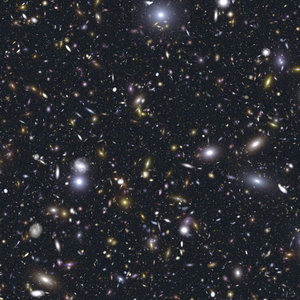Looking back in time
Aiming the world’s most sophisticated telescope at the same piece of sky for 28 days in a row allows us to see much farther out into the Universe, and further back in time!
Like a camera using a very long exposure, the NASA/ESA Hubble Space Telescope has seen deeper into the visible Universe than ever before, and produced an image called the ‘Hubble Ultra Deep Field’.
The region photographed is in the constellation Fornax, just below the constellation Orion. The image spans just one-tenth of the diameter of the full Moon, but contains an estimated 10,000 galaxies and some which are up to four times fainter than previously seen.
Looking far out into the Universe is also looking back in time, so Hubble has now taken us to within a stone's throw of the ‘Big Bang’ event itself. Hubble can now see the first galaxies to emerge from the so-called ‘dark ages’, the time shortly after the Big Bang when the first stars reheated the cold, dark Universe. Galaxies evolved so quickly in the Universe that their most important changes happened here within a 1000 million years of the Big Bang.
This image will also hold a number of surprises that will lead to unexpected discoveries. The first Hubble Deep Field from 1995 opened up a whole new area of research. Before then nobody was sure if you would actually achieve anything by observing the same patch of sky for weeks - but the results were astonishing!
Almost 3000 galaxies were seen in that first Deep Field image. After this image was produced, many ground- and space-based telescopes were aimed at areas of sky for long periods. Some of the most interesting results seemed to emerge from these fruitful co-operations between instruments of different sizes, in different environments and with sensitivities to different wavelengths.
This historic new view is actually two separate images taken by Hubble's Advanced Camera for Surveys (ACS) and the Near Infrared Camera and Multi-object Spectrometer (NICMOS). The combination of ACS and NICMOS images will be used to search for galaxies that existed between 800 and 400 million years after Big Bang.
The Hubble Deep Field images have made some of the greatest impacts on observational cosmology so far. These impressive dips into the depths of space and time have allowed astronomers to glimpse the first steps of galaxy formation more than 10 000 million years ago and are without doubt some of the great legacies of the Hubble Space Telescope.
The NASA/ESA Hubble Ultra Deep Field is likely to remain the deepest image of the Universe for the next decade or so, until ESA launches the James Webb Space Telescope in collaboration with NASA in 2011.















 Germany
Germany
 Austria
Austria
 Belgium
Belgium
 Denmark
Denmark
 Spain
Spain
 Estonia
Estonia
 Finland
Finland
 France
France
 Greece
Greece
 Hungary
Hungary
 Ireland
Ireland
 Italy
Italy
 Luxembourg
Luxembourg
 Norway
Norway
 The Netherlands
The Netherlands
 Poland
Poland
 Portugal
Portugal
 Czechia
Czechia
 Romania
Romania
 United Kingdom
United Kingdom
 Slovenia
Slovenia
 Sweden
Sweden
 Switzerland
Switzerland
































